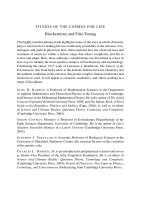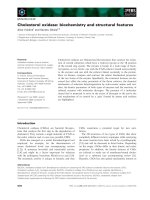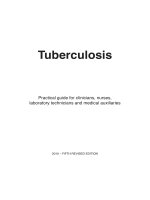Kaplan USMLE-1 (2013) - Biochemistry and Medical Genetics
Bạn đang xem bản rút gọn của tài liệu. Xem và tải ngay bản đầy đủ của tài liệu tại đây (31.11 MB, 430 trang )
�APLAtY
MEDICAL
USMLE™. Step 1
Biochemistry and Medical Genetics
Lecture Notes
BK4029J
*USMLE™ is a joint program of the Federation of State Medical Boards of the United States and the National Board of Medical Examiners.
©2013
Kaplan, Inc.
All rights reserved. No part of this book may be reproduced in any form, by photostat,
microfilm, xerography or any other means, or incorporated into any information retrieval
system, electronic or mechanical, without the written permission of Kaplan, Inc.
Not for resale.
BIOCHEMISTRY
MEDICAL GENETICS
Author
Author
Sam Turco, Ph.D.
Vernon Reichenbecher, Ph.D.
Professor, Department of Biochemistry
Professor Emeritus, Department of
Biochemistry & Molecular Biology
University of Kentucky College of Medicine
Lexington, KY
Marshall University School of Medicine
Huntington, WV
Contributors
Roger Lane, Ph.D.
Professor, Department of Biochemistry
University of South Alabama College of Medicine
Mobile, AL
David Seastone, D.O., Ph.D.
Department of Hematology/Oncology
Cleveland Clinic - Taussig Cancer Institute
Cleveland, OH
Previous contributions by Barbara Hansen, Ph.D. and Lynn B. Jorde, Ph.D.
Contents
Preface
.
.
.
.
.
.
.
.
.
.
.
.
.
.
.
.
.
.
.
.
.
.
.
.
.
.
.
.
.
.
.
.
.
.
.
.
.
.
.
.
.
.
.
.
.
.
.
.
.
.
.
.
.
.
.
.
.
.
vii
.
Section I : Molecular Biology and Biochemistry
Chapter 1: Nucleic Acid Structure and Organization
Chapter 2: DNA Replication and Repair.
.
.
.
.
Chapter 3: Transcription and RNA Processing
.
.
.
.
.
.
.
.
.
.
.
.
.
.
.
.
.
.
.
.
.
.
.
.
.
.
.
.
.
.
.
.
.
.
.
.
.
.
.
.
.
.
.
.
.
.
.
.
.
.
.
.
.
.
.
.
.
.
.
.
.
.
.
.
.
.
.
.
.
.
.
.
.
.
.
.
.
.
.
.
.
.
.
.
.
.
.
.
.
.
.
.
.
.
.
.
.
.
.
.
.
.
.
.
..
Chapter 4: The Genetic Code, Mutations, and Translation.
Chapter 5: Regulation of Eukaryotic Gene Expression
Chapter 6: Recombinant DNA .
.
.
.
..
.
.
.
.
Chapter 7: Techniques of Genetic Analysis
.
.
.
.
.
.
.
.
.
.
.
.
.
.
.
.
.
.
.
.
.
.
.
.
.
.
.
.
.
.
Chapter 8: Amino Acids, Proteins, and Enzymes
.
.
.
.
.
.
.
.
.
.
.
.
3
17
33
49
73
83
101
. 117
.
Chapter 9: Hormones ..................... . ................ . 133
.
Chapter 10: Vitamins
.
.
.
.
.
.
.
.
.
.
.
.
.
.
.
...
.
.
Chapter 1 1: Overview of Energy Metabolism
.
.
.
.
.
.
.
.
.
.
.
.
.
.
.
.
.
.
.
.
.
.
.
.
.
.
.
.
.
.
.
.
.
.
.
.
.
.
.
.
. 147
.
. 159
Chapter 12: Glycolysis and Pyruvate Dehydrogenase ............. 169
.
Chapter 13: Citric Acid Cycle and Oxidative Phosphorylation ...... . 187
.
Chapter 14: Glycogen, Gluconeogenesis, and the Hexose
Monophosphate Shunt. ................ ....... ... . 199
.
Chapter 15: Lipid Synthesis and Storage
.
.
.
.
.
.
.
.
.
.
.
.
.
.
.
.
.
.
.
.
.
.
.
.
.
.
217
�
M E D I CA L
V
Chapter 16: Lipid Mobilization and Catabolism
Chapter 17: Amino Acid Metabolism
.
.
.
.
.
.
.
.
.
Chapter 18: Purine and Pyrimidine Metabolism
.
.
.
.
.
.
.
.
.
.
.
.
.
.
.
.
.
.
.
.
.
.
.
.
.
.
.
.
.
.
.
.
.
.
.
.
.
.
.
.
.
.
.
.
.
.
.
.
.
.
.
.
.
.
.
.
.
239
261
287
Section I I. Medical Genetics
Chapter 1: Single-Gene Disorders
Chapter 2: Population Genetics
Chapter 3: Cytogenetics
.
.
.
.
.
.
.
.
.
.
.
.
.
.
.
.
.
.
.
.
.
.
.
.
.
.
.
.
.
.
.
.
.
.
.
.
.
.
.
.
.
.
.
.
.
.
.
.
.
.
.
.
.
.
.
.
.
.
.
.
.
.
.
.
.
.
.
.
.
.
.
.
.
.
.
.
.
.
.
.
.
.
.
.
.
.
.
.
.
.
.
.
.
.
.
.
.
.
.
.
.
.
.
.
.
.
.
.
.
.
.
.
.
.
.
.
.
.
.
.
.
.
.
C hapter 4: Genetics of Common Diseases
Chapter s: Gene Mapping
Index
Vi
�
M E D I CA L
.
.
.
Chapter 6: Genetic Diagnosis
.
.
.
.
.
.
.
.
.
.
.
.
.
.
.
.
.
.
.
.
.
.
.
.
.
.
.
.
.
.
.
.
.
.
.
.
.
.
.
.
.
.
.
.
.
.
.
.
.
.
.
.
.
.
.
.
.
.
.
.
.
.
.
.
.
.
.
.
.
.
.
.
.
.
.
.
.
.
.
.
.
.
.
.
.
.
.
.
.
.
.
.
.
.
.
.
.
.
.
.
.
.
.
.
.
.
.
.
.
.
.
.
.
.
.
.
.
.
.
.
.
.
.
.
.
.
.
.
.
303
333
347
.
371
383
395
411
Preface
These 7 volumes of Lecture Notes represent the most-likely-to-be-tested material
on the current USMLE Step 1 exam. Please note that these are Lecture Notes, not
review books. The Notes were designed to be accompanied by faculty lectures
live, on video, or on the web. Reading them without accessing the accompanying
lectures is not an effective way to review for the USMLE.
To maximize the effectiveness of these Notes, annotate them as you listen to lec
tures. To facilitate this process, we've created wide, blank margins. While these
margins are occasionally punctuated by faculty high-yield "margin notes;' they
are, for the most part, left blank for your notations.
Many students find that previewing the Notes prior to the lecture is a very effec
tive way to prepare for class. This allows you to anticipate the areas where you'll
need to pay particular attention. It also affords you the opportunity to map out
how the information is going to be presented and what sort of study aids (charts,
diagrams, etc.) you might want to add. This strategy works regardless of whether
you're attending a live lecture or watching one on video or the web.
Finally, we want to hear what you think. What do you like about the Notes? What
could be improved? Please share your feedback by e-mailing us at medfeedback@
kaplan.com.
Thank you for joining Kaplan Medical, and best of luck on your Step 1 exam!
Kaplan Medical
�
M E DICAL
Vii
SECTION
Molecular Biology and
Biochemistry
Nucleic Acid Structure
and Organization
1
OVERVIEW: CENTRAL DOGMA OF MOLECULAR BIOLOGY
An
organism must be able to store and preserve its genetic information, pass that
information along to future generations, and express that information as it carries
out all the processes oflife. The major steps involved in handling genetic informa
tion are illustrated by the central dogma of molecular biology (Figure 1- 1 - 1 ) . Ge
netic information is stored in the base sequence of DNA molecules. Ultimately,
during the process of gene expression, this information is used to synthesize all
the proteins made by an organism. Classically, a gene is a unit of the DNA that
encodes a particular protein or RNA molecule. Although this definition is now
complicated by our increased appreciation of the ways in which genes may be
expressed, it is still useful as a general, working definition.
Replication
Transcription
Translation
� IProteinJ
'-.___../
�--..,..
Reverse
transcription
Figure 1-1-1. Central Dogma of Molecular Biology
Gene Expression and D NA Replication
Gene expression and DNA replication are compared in Table 1- 1 - 1 . Transcrip
tion, the first stage in gene expression, involves transfer of information found in
a double-stranded DNA molecule to the base sequence of a single-stranded RNA
molecule. If the RNA molecule is a messenger RNA, then the process known as
translation converts the information in the RNA base sequence to the amino acid
sequence of a protein.
When cells divide, each daughter cell must receive an accurate copy of the genetic
information. DNA replication is the process in which each chromosome is dupli
cated before cell division.
�
M E D I CAL
3
Section I • Molecular Biology and Biochemistry
Table 1-1-1. Comparison of Gene Expression and DNA Replication
Gene Expression
ONA Replication
Produces all the proteins an organism
requires
Duplicates the chro mosomes before
cell division
Transcription of D NA: RNA copy of
a small section of a chromosome
(average size of h u m an gene, 104-1os
nucleotide pairs)
DNA copy of entire chromosome
(average size of human chromosome,
108 n ucleotide pairs)
Transcription occurs i n the n ucleus
throughout interphase
Occurs during S phase
Translation of RNA (protein synthesis)
occurs i n the cytoplasm throughout
the cell cycle.
Replication in n ucleus
The concept of the cell cycle (Figure I-1-2) can be used to describe the timing of
some of these events in a eukaryotic cell. The M phase (mitosis) is the time in
which the cell divides to form two daughter cells. Interphase is the term used to
describe the time between two cell divisions or mitoses. Gene expression occurs
throughout all stages of interphase. Interphase is subdivided as follows:
• G1 phase (gap 1 ) is a period of cellular growth preceding DNA synthesis.
Cells that have stopped cycling, such as muscle and nerve cells, are said
to be in a special state called G0•
• S phase (DNA synthesis) is the period of time during which DNA repli
Note
Many chemotherapeutic agents
function by targeting specific p hases
of the cell cycle. This is a frequently
tested area on the USM LE. Below are
some of the commo n ly tested agents
with the appropriate phase of the cell
cycle they target:
• 5-phase: m ethotrexate, 5-flurouracil,
cation occurs. At the end of S phase, each chromosome has doubled its
DNA content and is composed of two identical sister chromatids linked
at the centromere.
• G2 phase (gap 2) is a period of cellular growth after DNA synthesis but
preceding mitosis. Replicated DNA is checked for any errors before cell
division.
M
hydroxyurea
•
G2 phase: bleomycin
• M phase: paclitaxel, vincristine,
vin blastin e
• N o n cell-cycle specific:
s
cyclophosphamide, cisplatin
Figure 1-1-2. The Eukaryotic Cell Cycle
4
�
MEDI CAL
Chapter i. • Nucleic Acid Structure and Organization
Reverse transcription, which produces DNA copies of an RNA, is more com
monly associated with life cycles of retroviruses, which replicate and express their
genome through a DNA intermediate (an integrated provirus). Reverse tran
scription also occurs to a limited extent in human cells, where it plays a role in
amplifying certain highly repetitive sequences in the DNA (Chapter 7).
N UCLEOTIDE STRUCTURE AND NOMENCLATURE
Nucleic acids (DNA and RNA) are assembled from nucleotides, which consist
of three components: a nitrogenous base, a five-carbon sugar (pentose), and
phosphate.
Five-Carbon Sugars
Nucleic acids (as well as nucleosides and nucleotides) are classified according to
the pentose they contain. If the pentose is ribose, the nucleic acid is RNA (ribo
nucleic acid); if the pentose is deoxyribose, the nucleic acid is DNA (deoxyribo
nucleic acid).
Bases
There are two types of nitrogen-containing bases commonly found in nucleo
tides: purines and pyrimidines (Figure 1- 1 -3):
H2 H:):> H2 :) :ocH,
(:()H H2J-, )jH olH H
Purines
N
Pyrimidines
0
0
N
0
NH
�
Adenine
Figure 1-1-3.
�
Guanine
Cytosine
Uracil
Thymine
Bases Commonly Found in Nucleic Acids
• Purines contain two rings in their structure. The two purines com
monly found in nucleic acids are adenine (A) and guanine (G); both are
found in DNA and RNA. Other purine metabolites, not usually found in
nucleic acids, include xanthine, hypoxanthine, and uric acid.
• Pyrimidines have only one ring. Cytosine (C) is present in both DNA
and RNA. Thymine (T) is usually found only in DNA, whereas uracil
(U) is found only in RNA.
Nucleosides and Nucleotides
Nucleosides are formed by covalently linking a base to the number 1 carbon of a
sugar (Figure 1-1-4). The numbers identifying the carbons of the sugar are labeled
with "primes" in nucleosides and nucleotides to distinguish them from the car
bons of the purine or pyrimidine base.
�
M E D I CAL
5
Section I • Molecular Biology and Biochemistry
>
Adenosine
N H2
N ::/"'
�
N
5' CH20H
Deoxythymidine
N
N
1'
OH
Figure 1-1-4. Examples of Nucleosides
Nucleotides are formed when one or more phosphate groups is attached to the 5'
carbon of a nucleoside (Figure I-1-5). Nucleoside di- and triphosphates are high
energy compounds because of the hydrolytic energy associated with the acid an
hydride bonds (Figure I-1 -6).
Uridine Monophosphate
(UMP)
Deoxyguanosine Monophosphate
(dGMP)
:X >
0
N
ATP
HN
H,
High-energy
bonds
o
{ �\i
o
o
II
I
II
0- P- O- P- O- P- O- CH 2 0
_
I
o-
I
o-
11
0
_
I
o-
�
a N ucleoside Triphosphate
N
5'
0- P- O- CH2
I
o-
OH O H
Figure 1-1-6. High-Energy Bonds i n
N
O
1'
OH
Figure 1-1-5. Examples of Nucleotides
The nomenclature for the commonly found bases, nucleosides, and nucleotides is
shown in Table I-1-2. Note that the "deoxy" part of the names deoxythymidine,
dTMP, etc., is sometimes understood, and not expressly stated, because thymine
is almost always found attached to deoxyribose.
6
�
M E D I CA L
Chapter 1 • Nucleic Acid Structure and Organization
Table 1-1-2. Nomenclature of Im portant Bases, Nucleosides, and Nucleotides
Base
Nucle oside
Nucleotides
Adenine
Adenosine
(Deoxyadenosine)
AMP (dAMP)
ADP (dAD P)
ATP (dATP)
Guanine
Guanosine
(Deoxyguanosine)
GMP (dGM P)
G D P (dG D P)
GTP (dGTP)
Cytosi ne
Cytidine
(Deoxycyti dine)
CMP (dCMP)
CDP (dCDP)
CTP (dCTP)
U racil
Uridine
(Deoxyuridine)
UMP (d UMP)
UDP (dU D P)
UTP (dUTP)
Thym ine
(Deoxythym idine)
(dTMP)
(dTDP)
(dTIP)
Names of nucleosides and nucleotides attached to deoxyribose are shown in parentheses.
NUCLEIC ACIDS
Nucleic acids are polymers of nucleotides joined by 3', 5'-phosphodiester bonds;
that is, a phosphate group links the 3' carbon of a sugar to the 5' carbon of the
next sugar in the chain. Each strand has a distinct 5' end and 3' end, and thus has
polarity. A phosphate group is often found at the 5' end, and a hydroxyl group is
often found at the 3' end.
The base sequence of a nucleic acid strand is written by convention, in the 5'�3'
direction (left to right). According to this convention, the sequence of the strand
on the left in Figure 1-1-7 must be written
In
a Nutshell
N ucleic Acids
• Nucleotides linked by 3', 5'
phosphodiester bonds
• Have distinct 3' and 5' ends,
thus polarity
• Sequence is always specified as
5'�3'
5'-TCAG-3' or TCAG:
• If written backward, the ends must be labeled: 3'-GACT-5'
• The positions of phosphates may be shown: pTpCpApG
• In DNA, a "d" (deoxy) may be included: dTdCdAdG
In eukaryotes, DNA is generally double-stranded (dsDNA) and RNA is gener
ally single-stranded (ssRNA). Exceptions occur in certain viruses, some of which
have ssDNA genomes and some of which have dsRNA genomes.
�
M E D I CAL
7
S e ction I • Molecular Biology and Biochemistry
s·- Phosphate
3·- Hydroxyl
QI
HC3 0 ------------H-NHHNI OH
M-H-----------N� J-N
N�O
�N
0
5'CH2
0
I
I1 =0
-o-P=O
LH----------- 'r- l/ 0
<70 - - ----- H- � G }-N
sL,
N�O-------- -- H- >=N
- �
5C' H2
0
H
N '\.N-H---- --------0 H3 0
\
I
-o-P=O
-o-P=O
�
�
0
N-{ �N- - ------- H-N�
I
N==.i
�N
5'CH2
0
0-P=O
6
s6H,
I
�
A
I
- o-
o
I
---
v
I
I
A
I
0
-O-P=O
0
5'CH2
I
I
I
o
�
5'CH2
I
�-
�
-o-
0I
-o
-o
s·CH2
- 9P O
0-I
I
=
5'
5· _Phosphate
Figure 1-1-7.
M E D ICAL
I
c
3'- Hydroxyl
8
0
N - ----- - H NH
--- - - - - h
(
H
N--!( G � - H-------------· N\ l
N==< -H- ---- ----0�N
;
OH
3'
I
Hydrogen-Bonded Base Pairs in DNA
Chapter 1 • Nucleic Acid Structure and Organization
DNA Structure
Note
Figure I- 1 -8 shows an example of a double-stranded DNA molecule. Some of the
features of double-stranded DNA include:
Using Chargaff's Rules
• The two strands are antiparallel (opposite in direction).
• The two strands are complementary. A always pairs with T (two hydrogen
bonds), and G always pairs with C (three hydrogen bonds). Thus, the base
sequence on one strand defines the base sequence on the other strand.
• Because of the specific base pairing, the amount of A equals the amount
of T, and the amount of G equals the amount of C. Thus, total purines
equals total pyrimidines. These properties are known as Chargaff's rules.
With minor modification (substitution ofU for T) these rules also apply to dsRNA.
Most DNA occurs in nature as a right-handed double-helical molecule known as
Watson-Crick DNA or B-DNA (Figure I-1 -8). The hydrophilic sugar-phosphate
backbone of each strand is on the outside of the double helix. The hydrogenbonded base pairs are stacked in the center of the molecule. There are about 1 0
base pairs per complete turn of the helix. A rare left-handed double-helical form
of DNA that occurs in G-C-rich sequences is known as Z-DNA. The biologic
function of Z-DNA is unknown , but may be related to gene regulation.
In dsDNA (or dsRNA)
(ds= double-stranded)
% A=% T (% U)
% G=% C
% purin es = % pyri midines
A sample of DNA has 1 0% G ;
what is the % T?
10% G + 1 0% C = 20%
therefore, % A + % T m ust total 80%
40% A and 40% T
Ans: 40% T
Bridge to Pharmacology
�
CG·=-
--
}
Major
Groove
Minor
""
binding sites
/ forProvide
regulatory proteins
Groove
Daunorubicin and doxorubicin are
antitumor drugs that are used in the
treatment of leukemias. They exert their
effects by intercalating between the
bases of DNA, thereby interfering with
the activity oftopoisomerase II and
preventing proper replication of the DNA.
Other d rugs, such as cisplatin, which
is used in the treatment of bladder
and lung tumors, bind tightly to the
D NA, causing structural distortion and
malfunction.
Figure 1-1-8.
The B-DNA Double Helix
�
M E D ICAL
9
Section I • Molecular Biology and Biochemistry
Denaturation and Renaturation of DNA
Double-helical DNA can be denatured by conditions that disrupt hydrogen
bonding and base stacking, resulting in the "melting" of the double helix into two
single strands that separate from each other. No covalent bonds are broken in this
process. Heat, alkaline pH, and chemicals such as formamide and urea are com
monly used to denature DNA.
1
Denaturation
(heat)
1
Renaturation
(cooling)
Double-stranded DNA
�
Single-stranded DNA
Denatured single-stranded DNA can be renatured (annealed) if the denaturing
condition is slowly removed. For example, if a solution containing heat-dena
tured DNA is slowly cooled, the two complementary strands can become base
paired again (Figure I -1-9).
Such renaturation or annealing of complementary DNA strands is an important
step in probing a Southern blot and in performing the polymerase chain reaction
(reviewed in Chapter 7). In these techniques, a well-characterized probe DNA is
added to a mixture of target DNA molecules. The mixed sample is denatured and
then renatured. When probe DNA binds to target DNA sequences of sufficient
complementarity, the process is called hybridization.
ORGANIZATION OF DNA
Double-stranded DNA
Large DNA molecules must be packaged in such a way that they can fit inside the
cell and still be functional.
Figure 1-1-9. Denaturation
and Renaturation of DNA
Supercoiling
Mitochondrial DNA and the DNA of most prokaryotes are closed circular struc
tures. These molecules may exist as relaxed circles or as supercoiled structures in
which the helix is twisted around itself in three-dimensional space. Supercoiling re
sults from strain on the molecule caused by under- or overwinding the double helix:
• Negatively supercoiled DNA is formed if the DNA is wound more
loosely than in Watson-Crick DNA. This form is required for most
biologic reactions.
• Positively supercoiled DNA is formed if the DNA is wound more tightly
than in Watson-Crick DNA.
• Topoisomerases are enzymes that can change the amount of supercoiling
in DNA molecules. They make transient breaks in DNA strands by alter
nately breaking and resealing the sugar-phosphate backbone. For example,
in Escherichia coli, DNA gyrase (DNA topoisomerase II) can introduce
negative supercoiling into DNA.
10
�
M E D I CAL
Chapter 1 • Nucleic Acid Structure and Organization
N ucleosomes and Chromatin
Without
+HI
Expanded view of
a nucleosome
Expanded view
Figure 1-1-10.
Nucleosome and Nucleofilament
Structure in Eukaryotic DNA
Nuclear DNA in eukaryotes is found in chromatin associated with histones and
nonhistone proteins. The basic packaging unit of chromatin is the nucleosome
(Figure 1-1-10):
• Histones are rich in lysine and arginine, which confer a positive charge
on the proteins.
• Two copies each of histones H2A, H2B, H3, and H4 aggregate to form
the histone octamer.
• DNA is wound around the outside of this octamer to form a nucleo
some (a series of nucleosomes is sometimes called "beads on a string",
but is more properly referred to as a l Onm chromatin fiber).
• Histone Hl is associated with the linker DNA found between nucleo
somes to help package them into a solenoid-like structure, which is a
thick 30-nm fiber.
• Further condensation occurs to eventually form the chromosome. Each
eukaryotic chromosome in Go or G 1 contains one linear molecule of
double-stranded DNA.
Cells in interphase contain two types of chromatin: euchromatin (more opened
and available for gene expression) and heterochromatin (much more highly con
densed and associated with areas of the chromosomes that are not expressed.)
(Figure 1-1-1 1).
�
M E D I CA L
11
Section I • Molecular Biology and Biochemistry
Less active
More active
-
DNA double helix
1 O nm chromatin
-
-
30 nm chromatin
I
30 nm f ib er forms loops attached Higher order
to scaffolding proteins
packaging
Heterochromatin
Euchromatin
Figure 1-1-11. DNA Packaging in Eukaryotic Cell
Euchromatin generally corresponds to the nucleosomes (10-nm fibers) loosely as
sociated with each other (looped 30-nm fibers). Heterochromatin is more highly
condensed, producing interphase heterochromatin as well as chromatin charac
teristic of mitotic chromosomes. Figure 1- 1-12 shows an electron micrograph of
an interphase nucleus containing euchromatin, heterochromatin, and a nucleolus.
The nucleolus is a nuclear region specialized for ribosome assembly (discussed in
Chapter 3).
Euchromatin
Figure 1-1-12. An lnterphase N ucleus
During mitosis, all the DNA is highly condensed to allow separation of the sister
chromatids. This is the only time in the cell cycle when the chromosome struc
ture is visible. Chromosome abnormalities may be assessed on mitotic chromo
somes by karyotype analysis (metaphase chromosomes) and by banding tech
niques (prophase or prometaphase), which identify aneuploidy, translocations,
deletions, inversions, and duplications.
12
�
MED I CAL
Chapter 1 • Nucleic Acid Structure and Organization
Chapter Summary
• N ucleic acids:
- RNA and DNA
- Nucleotides (nucleoside monophosphates) linked by phosphodiester bonds
- H ave polarity (3' end versus 5' end)
- Sequence always specified 5'-to-3' (left to right on page)
• Double-stranded n ucleic acids:
- Two strands associate by hydrogen bonding
- Sequences are com plementary and anti parallel
• Eukaryotic DNA in the n ucleus:
- Packaged with h istones (H2 a, H 2 b, H3, H4) 2 to form nucleosomes
(10-nm fiber)
- 1 0-nm fiber associates with H l (30-nm fiber) .
- 1 0-nm fiber a n d 30-nm fiber comprise euchromatin (active gene expression).
- H igher-order packaging forms heterochromatin (no gene expression).
- Mitotic DNA most condensed (no gene expression)
�
M E D ICAL
13
Section I • Molecular Biology and Biochemistry
Review Questions
Select the ONE best answer.
1. A double-stranded RNA genome isolated from a virus in the stool of a child
with gastroenteritis was found to contain 15% uracil. What is the percent
age of guanine in this genome?
A.
B.
15
25
c. 35
D. 75
E.
85
2. What is the structure indicated below?
4'
A.
B.
C.
D.
E.
Purine nucleotide
Purine
Pyrimidine nucleoside
Purine nucleoside
Deoxyadenosine
3. Endonuclease activation and chromatin fragmentation are characteristic
features of eukaryotic cell death by apoptosis. Which of the following chro
mosome structures would most likely be degraded first in an apoptotic cell?
Barr body
10-nm fiber
c. 30-nm fiber
D. Centromere
E. Heterochromatin
A.
B.
14
�
M E D I CAL
Chapter 1 • Nucleic Acid Structure and Organization
4.
A medical student working in a molecular biology laboratory is asked by
her mentor to determine the base composition of an unlabeled nucleic acid
sample left behind by a former research technologist. The results of her analy
sis show 10% adenine, 40% cytosine, 30% thymine and 20% guanine. What
is the most likely source of the nucleic acid in this sample?
A.
Bacterial chromosome
B.
Bacterial plasmid
C.
Mitochondrial chromosome
D.
Nuclear chromosome
E.
Viral genome
Answers
1.
Answer: C.
U=A= 15%.
Since A + G = 50%, G
=
35%.
Alternatively, U =A= 15%, then U +A= 30%
C + G = 70%, and
G = 35%.
2.
Answer: D. A nucleoside consists of a base and a sugar. The figure shows
the nucleoside adenosine, which is the base adenine attached to ribose.
3.
Niswer: B. The more "opened" the DNA, the more sensitive it is to
enzyme attack. The 10-nm fiber, without the Hl, is the most open struc
ture listed. The endonuclease would attack the region of unprotected
DNA between the nucleosomes.
4.
Answer: E. A base compositional analysis that deviates from Chargaff's
rules (%A= o/oT, o/oC= o/oG) is indicative of single-stranded, not double
stranded, nucleic acid molecule. All options listed except
E are examples
of circular (choices A, B and C) or linear (choice D) DNA double helices.
Only a few viruses (e.g. parvovirus) have single-stranded DNA.
�
M E D ICAL
15









